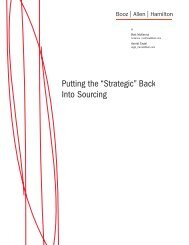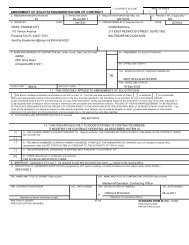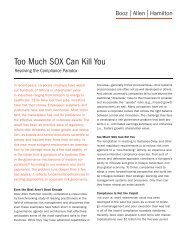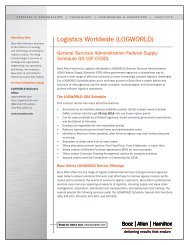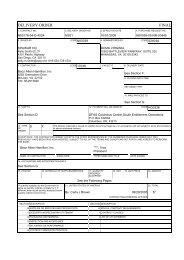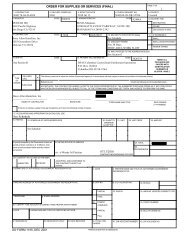Spans & Layers - Booz Allen Hamilton
Spans & Layers - Booz Allen Hamilton
Spans & Layers - Booz Allen Hamilton
Create successful ePaper yourself
Turn your PDF publications into a flip-book with our unique Google optimized e-Paper software.
Management <strong>Spans</strong> and <strong>Layers</strong>Streamlining the Out-of-Shape OrganizationDo you recognize the hourglass organization (seeExhibit 1)? If you look closely at the managementranks of many Fortune 500 corporations, you’ll seethis unfortunate phenomenon: excessive layersand narrow spans of control, particularly amongmid-level directors and managers. The result isoften bureaucratic buildup, bottle-necked decisionmaking,and a general lack of innovation. Employeeslaboring at the customer-facing end of thisattenuated organization structure are hamstrungby vertical decision-making and multi-matrixed reportingrelationships. Their career prospects areunenticing and their creativity diminished. The viewat the top is equally uninspiring…and crowded. Organizationslike these need to look beyond simpleheadcount reductions to find more lasting and effectivemethods for getting in shape.Rooting Out the Underlying CausesThe objective in streamlining the hourglass organizationis not just the obvious potential for strippingout excess cost; it’s the concomitant opportunity toincrease revenues by simplifying decision-making,enhancing customer responsiveness, and unleashinginnovation. Achieving these benefits, however, requiresa new approach to organizational restructuring, onepredicated on true and lasting behavior change,rather than slashing boxes on an organization chart.Headcount reduction alone is a shortsighted remedy;it does not address the underlying drivers of organizationalobesity. Indeed, it can often do more harm thanExhibit 1The “Hourglass” Organization Source: <strong>Booz</strong> <strong>Allen</strong> <strong>Hamilton</strong> 4 4 4 4 4 4 good. Companies thinning their ranks often either cutinto the productive muscle of the organization or lopoff excess positions only to have them reappear elsewherea few months later.To achieve enduring, productive gains, companies needto look more than skin-deep for solutions. They need tolook beyond organizational charts and job descriptionsto the company’s “DNA”—the collection of behaviors,
2Exhibit 2Organization DNA Encompasses a Lot More than StructureThe Four Building Blocks of Organization DNADecision RightsThe underlying mechanicsof how and by whomdecisions are truly made,beyond the lines and boxesof the organization chartMotivatorsWhat objectives,incentives, and careeralternatives do peoplehave? How are peopleinfluenced by thecompany's history?Source: <strong>Booz</strong> <strong>Allen</strong> <strong>Hamilton</strong>InformationWhat metrics are used tomeasure performance?How are activitiescoordinated, and how isknowledge transferred?StructureThe overall organizationmodel, including the"lines and boxes" of theorganizationassumptions, beliefs, habits, incentives, and rules thatdetermine how people work together (see Exhibit 2).An organization’s DNA is less visible and harder to getat, but it is essential to motivating stronger performanceand ensuring sustainable gains.While proliferating lines and boxes on an org chartare an important indicator, not all spans are createdequal; some spans legitimately should be narrowerthan others. But narrow spans can also be symptomsof serious organizational problems. By this logic, eliminatinglines and boxes does not cure a dysfunctionalorganization; it merely masks the symptoms. The rootcauses of organizational dysfunction and obesity aremore fundamental:Root Cause #1: Lack of Accountability“We need to protect our employees from themselves”Organizations that do not hold employees accountablefor their actions, results, and budget commitmentsbreed a culture of mistrust and incur extra costs associatedwith excessive oversight. Additional layers ofmanagement become institutionalized to “chaperone”employees as they make day-to-day decisions. Fromthe outside, the organization looks bureaucratic and/orincompetent, when the real culprit is ill-defined accountabilitiesand performance measures. There is no licensefor employees to improve the organization and noincentive to deliver against critical objectives. Moreover,redundant levels and approvals enable everyone to passthe buck until the people making the decisions are nolonger accountable for the decisions they make.Root Cause #2: Suboptimizing Silos“What’s good for my unit is good for the company”Business unit and/or functional silos will naturally cropup in any large, complex organization as managerscompete for capital and other resources. In the attemptto optimize individual performance, however, businessunits and functions often suboptimize the overall company’sperformance. Typical symptoms of silo behaviorinclude poorly placed investments, redundant staffingand services, and inconsistent messages to the marketplace.While some might diagnose the symptomsas warring internal factions, the truth is most units andfunctions probably don’t know each other well enoughto battle. The organization is too highly fragmentedand/or dispersed, and corporate coordination and governancemechanisms are absent. Ironically, this veryfragmentation drives the need for more managers tocoordinate both within and across silos.Root Cause #3: Micromanagers“Our managers like to get their hands dirty”It’s no coincidence that slow-moving organizations tendto be bloated in their midsection with multiple layersof management, all eager to justify their positions. Inpursuit of that goal, they “make work,” manifesting aninsatiable desire for detail and requests for tremendousvolumes of information that must be assimilatedand reconciled at each level. Excessive time is spentrequesting, tracking, and approving spending, personnel,and operating decisions. While the resulting organizationalsclerosis could be attributed to inexperiencedor incompetent subordinates, the root cause is management’sunwillingness to delegate decision rights tothose employees closest to the relevant information.Root Cause #4: Implied Promotion Promises“It’s been two years…time for another promotion”In the paternalistic corporate cultures of yore, it was anarticle of faith that promotions automatically accruedto those solid performers who “did their time” in a particularposition. That practice has fostered unrealistic
3career advancement expectations among the currentgeneration of middle managers. To keep the best andthe brightest from exiting, companies are instituting“promote from within” policies and dangling verticaladvancement opportunities. The problem is too manycompanies rely on promotion as their chief incentivemechanism, placing pressure on the organization structureto create additional—and largely artificial—levelsof management.How to Be Flat and Happy…for GoodAs with any type of organization change, there is nosingle best way to remove layers. Some start at thetop, with the CEO or CFO commissioning an organizationaudit. After benchmarking the organization againstinternal and external best practices, the senior teamsets stretch goals to restructure management spansand flatten layers.Others “bubble up” solutions from below by engagingthe entire organization in “spans and layers”interviews and workouts. These sessions drill downto uncover the root causes of dysfunctional organizationstructures. Once these root causes are identified,organization leaders are charged with addressingthem. Solutions might include setting up self-managingteams, altering management and employee responsibilitiesand incentives, and redesigning career paths.Whichever solution is adopted, however, it is wise toremember the eight tenets of genetic reengineeringwhen it comes to organizational DNA.1. Not all spans are created equal. Avoid the seductionof simplistic targets (e.g., “no more than five managementlayers/no fewer than three direct reports”).Sustained improvements hinge on developing theright size and number of building blocks based onthe nature of work, the core business processesinvolved, and the interactions required to drive smartdecision-making.2. Create cross-functional teams with process ownersaround key business processes. These teams cannotbe afterthoughts or window dressings. They needreal authority.3. Design fulfilling career paths and staffing strategies,including horizontal moves and increased compensation,to challenge and reward managers faced withfewer classic upward promotion opportunities.4. De-program micromanagers. Train and hold accountablethe next generation of middle management todelegate more decisions to the front lines where relevantinformation resides.Case Study: <strong>Spans</strong> and <strong>Layers</strong>As the lead initiative in an overall global effectivenessprogram, a Fortune 100 client of <strong>Booz</strong> <strong>Allen</strong> <strong>Hamilton</strong>launched a “spans and layers” program designed toreduce high G&A costs driven by organizational complexity.Recognizing that the existing multi-matrix structurewas costly, sluggish, uncoordinated, and inwardlyfocused, management was convinced that a flatterand more streamlined organization model was criticalto effecting its strategy and competing in a globalmarketplace. The team charged with leading this effortfollowed a four-step process over a period of 12 weeks,first baselining the existing spans and layers, then sizingthe prize from a top-down perspective, then designingand implementing solutions to reduce layers andoptimize the organization model. In the end, the companyrealized approximately $200 million in savings,which constituted 25% of the total cost savings generatedby the entire global effectiveness program. Source: <strong>Booz</strong> <strong>Allen</strong> <strong>Hamilton</strong>4 4 4 4 4 4 4 4 4 4 4 4 4
45. Modify job titles and compensation levels to reflectand encourage more simplified and streamlined workprocesses.6. Institutionalize communications vehicles to breakthrough traditional roadblocks to the free flow ofinformation.7. Implement measures and incentives that sharpenthe organization’s focus on accountability and consequencesfor performance gains and losses.8. Coach the change agents, the line managers who willnot only design and deliver the changes, but who willmost directly feel their implications.In a competitive environment where fleet-footed rivalsand finicky customers drive the pace of change everfaster, organizations need to be fit and flexible to prosper.Too many, however, are burdened with excessiveorganizational structure. Developing a flatter, morestreamlined profile is not only a key to reduced costsin the short term, it is an invitation to increased revenuesover the longer haul.What <strong>Booz</strong> <strong>Allen</strong> Brings<strong>Booz</strong> <strong>Allen</strong> <strong>Hamilton</strong> has been at the forefront of managementconsulting for businesses and governmentsfor more than 85 years. <strong>Booz</strong> <strong>Allen</strong> combines strategywith technology and insight with action, working withclients to deliver results today that endure tomorrow.With over 13,000 employees on six continents, thefirm generates annual sales of $2.2 billion. <strong>Booz</strong> <strong>Allen</strong>provides services in strategy, organization, operations,systems, and technology to the world’s leading corporations,government and other public agencies, emerginggrowth companies, and institutions.To learn more about the firm, visit the <strong>Booz</strong> <strong>Allen</strong>Web site at www.boozallen.com. To learn moreabout the best ideas in business, visit www.strategybusiness.com,the Web site for strategy+business, aquarterly journal sponsored by <strong>Booz</strong> <strong>Allen</strong>.Contact Information:ASIA-PACIFICSeoulJong Hyun ChangVice President82-2-2170-7600chang_jongh@bah.comEUROPEZurichJens SchädlerVice President41-1-206-40-54schadler_jens@bah.comNORTH AMERICAChicagoGary NeilsonSenior Vice President312-578-4727neilson_gary@bah.comSydneyIan BuchananVice President61-2-9321-2853buchanan_ian@bah.comLATIN AMERICARio de JaneiroPaolo PigoriniVice President55-21-2237-8400pigorini_paolo@bah.comChicagoVinay CoutoVice President312-578-4617couto_vinay@bah.comTokyoAkira UchidaVice President81-3-34360-8600uchida_akira@bah.comMIDDLE EASTBeirutJoe SaddiVice President961-1-336433saddi_joe@bah.comBostonEng-Ming TanSenior Associate617-428-4431tan_eng-ming@bah.comDownloadable digital versions of this article and other <strong>Booz</strong> <strong>Allen</strong> <strong>Hamilton</strong> publications are available from www.boozallen.com.20030070/10/03 PRINTED in USA©2003 <strong>Booz</strong> <strong>Allen</strong> <strong>Hamilton</strong> Inc.




